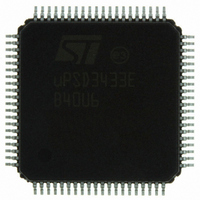UPSD3433EB40U6 STMicroelectronics, UPSD3433EB40U6 Datasheet - Page 245

UPSD3433EB40U6
Manufacturer Part Number
UPSD3433EB40U6
Description
MCU 8BIT 8032 128KB FLASH 80TQFP
Manufacturer
STMicroelectronics
Series
µPSDr
Datasheet
1.UPSD3434EB40T6.pdf
(293 pages)
Specifications of UPSD3433EB40U6
Core Processor
8032
Core Size
8-Bit
Speed
40MHz
Connectivity
I²C, IrDA, SPI, UART/USART, USB
Peripherals
LVD, POR, PWM, WDT
Number Of I /o
46
Program Memory Size
160KB (160K x 8)
Program Memory Type
FLASH
Ram Size
8K x 8
Voltage - Supply (vcc/vdd)
3 V ~ 5.5 V
Data Converters
A/D 8x10b
Oscillator Type
Internal
Operating Temperature
-40°C ~ 85°C
Package / Case
80-TQFP, 80-VQFP
For Use With
497-5518 - EVAL BOARD RFID READER497-5046 - KIT TOOL FOR ST7/UPSD/STR7 MCU
Lead Free Status / RoHS Status
Lead free / RoHS Compliant
Eeprom Size
-
Other names
497-5660
Available stocks
Company
Part Number
Manufacturer
Quantity
Price
Company:
Part Number:
UPSD3433EB40U6
Manufacturer:
STMicroelectronics
Quantity:
10 000
- Current page: 245 of 293
- Download datasheet (5Mb)
uPSD34xx
28.5.52
Automatic power-down (APD)
The APD unit shown in
by monitoring the activity of the 8032 Address Latch Enable (ALE) signal. If the APD unit is
enabled by writing a logic ’1’ to Bit 1 of the csiop PMMR0 register, and if ALE signal activity
has stopped (8032 in sleep mode), then the four-bit APD counter starts counting up. If the
ALE signal remains inactive for 15 clock periods of the CLKIN signal (pin PD1), then the
APD counter will reach maximum count and the power down indicator signal (PDN) goes to
logic ’1’ forcing the PSD Module into power-down mode. During this time, all buffers on the
PSD Module for 8032 address and data signals are disabled in silicon, preventing the PSD
Module memories from waking up from stand-by mode, even if noise or other devices are
driving the address lines. The PLDs will also stay in standby mode if the PLDs are in non-
Turbo mode and if all other PLD inputs (non-address signals) are static.
However, if the ALE signal has a transition before the APD counter reaches max count, the
APD counter is cleared to zero and the PDN signal will not go active, preventing power-
down mode. To prevent unwanted APD time-outs during normal 8032 operation (not
sleeping), it is important to choose a clock frequency for CLKIN that will NOT produce 15 or
more pulses within the longest period between ALE transitions. A 32768 Hz clock signal is
quite often an ideal frequency for CLKIN and APD, and this frequency is often available on
external supervisor or real-time clock devices.
The “PDN” power-down indicator signal is available to the PLD input bus to use in any PLD
equations if desired. The user may want to send this signal as a PLD output to an external
device to indicate the PSD Module is in power-down mode. PSDsoft Express automatically
includes the “PDN” signal in the DPLD chip select equations for FSx, CSBOOTx, RS0, and
CSIOP.
The following should be kept in mind when the PSD Module is in power-down mode:
●
●
●
●
●
●
The APD counter will count whenever Bit 1 of csiop PMMR0 register is set to logic '1,' and
when the ALE signal is steady at either logic ’1’ or logic ’0’ (not transitioning).
page 247
PSDsoft Express to enable APD mode is to select the pin function “Common Clock Input,
CLKIN” before programming with JTAG.
8032 address and data bus signals are blocked from all memories and both PLDs.
The PSD Module comes out of power-down mode when: ALE starts pulsing again, or
the CSI input on pin PD2 transitions from logic ’1’ to logic '0,' or the PSD Module reset
signal, RST, transitions from logic ’0’ to logic '1.'
Various signals can be blocked (prior to power-down mode) from entering the PLDs by
using “blocking bits” in csiop PMMR registers.
All memories enter standby mode, and the state of the PLDs and I/O Ports are
unchanged (if no PLD inputs change).
power-down mode on I/O pins while in various operating modes.
The 8032 Ports 1,3, and 4 on the MCU Module are not affected at all by power-down
mode in the PSD Module.
Power-down standby current given in the AC specifications for PSD Module assume
there are no transitions on any unblocked PLD input, and there are no output pins
driving any loads.
shows the flow leading up to power-down mode. The only action required in
Figure 74 on page 215
Table 148 on page 251
puts the PSD Module into power-down mode
shows the effects of
Figure 90 on
PSD module
245/293
Related parts for UPSD3433EB40U6
Image
Part Number
Description
Manufacturer
Datasheet
Request
R

Part Number:
Description:
MCU 8BIT 8032 128KB FLASH 80TQFP
Manufacturer:
STMicroelectronics
Datasheet:

Part Number:
Description:
MCU 8BIT 8032 128KB FLASH 52TQFP
Manufacturer:
STMicroelectronics
Datasheet:

Part Number:
Description:
STMicroelectronics [RIPPLE-CARRY BINARY COUNTER/DIVIDERS]
Manufacturer:
STMicroelectronics
Datasheet:

Part Number:
Description:
STMicroelectronics [LIQUID-CRYSTAL DISPLAY DRIVERS]
Manufacturer:
STMicroelectronics
Datasheet:

Part Number:
Description:
BOARD EVAL FOR MEMS SENSORS
Manufacturer:
STMicroelectronics
Datasheet:

Part Number:
Description:
NPN TRANSISTOR POWER MODULE
Manufacturer:
STMicroelectronics
Datasheet:

Part Number:
Description:
TURBOSWITCH ULTRA-FAST HIGH VOLTAGE DIODE
Manufacturer:
STMicroelectronics
Datasheet:

Part Number:
Description:
Manufacturer:
STMicroelectronics
Datasheet:

Part Number:
Description:
DIODE / SCR MODULE
Manufacturer:
STMicroelectronics
Datasheet:

Part Number:
Description:
DIODE / SCR MODULE
Manufacturer:
STMicroelectronics
Datasheet:

Part Number:
Description:
Search -----> STE16N100
Manufacturer:
STMicroelectronics
Datasheet:

Part Number:
Description:
Search ---> STE53NA50
Manufacturer:
STMicroelectronics
Datasheet:











